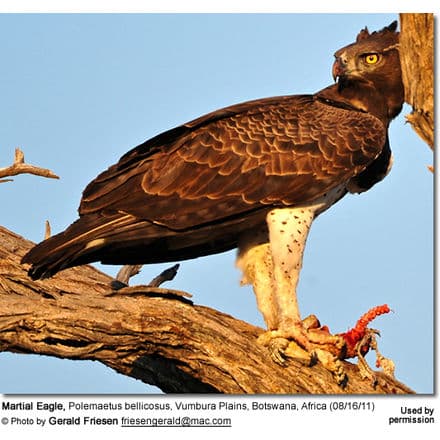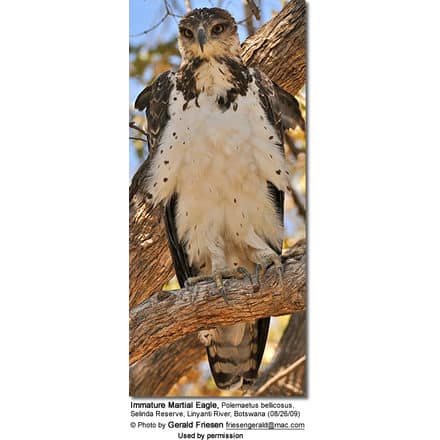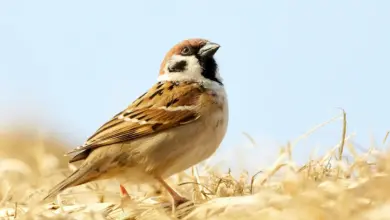Martial Eagles
The Martial Eagles (Polemaetus bellicosus) is Africa’s largest eagle and is the only member of the genus Polemaetus.
Range and habitat
The Martial Eagles can be found in all subsaharan Africa, wherever food is abundant and the environment favorable. It is never common, but greater population densities exist in southern Africa, especially in Zimbabwe and South Africa.
Generally, these birds are more abundant in protected areas, such as Kruger National Park and Kgalagadi Transfrontier Park in South Africa or Etosha National Park, in Namibia.
Its preferred habitat is the semidesert and open savanna. It avoids dense forests but needs trees to nest in.
The territory can vary greatly in size from more than 1000 Km² to areas where nests are less than 10 km distant. This disparity is due to differences in food supply.

Description
It is a large eagle, growing to a length of 76-83 cm with a wingspan of 190-260 cm. The adult’s plumage has dark brown upperparts, head, and upper chest.
The body underparts are white and streaked with black. The underwing coverts are brown, with pale flight feathers, also streaked with black.
The female is usually larger and more streaked than the male.
The immature is paler above and has white underparts. It reaches adult plumage in its seventh year.
Diet
The diet varies greatly with prey availability. Birds up to the size of a stork can be taken, but it chooses more often medium-sized ground-dwelling species such as francolins, guineafowl, or bustards.
In some areas, mammals constitute the greater part of its diet, with such species as hares, hyraxes, mongooses, and even young impalas. It can also attack domestic livestock, including poultry, lambs, and young goats, but this is never a great part of its diet.
The Martial Eagles hunts mostly in flight, circling high above its territory, and stooping sharply to catch its prey by surprise.


Nesting
Martial Eagles have no distinctive display flight but utter a loud cry `klee-klee-klee-kloeee-kloeee-kuleee’ during the mating period.
They build their nests in trees but also, in the Karoo desert( South Africa), on electric pylons. The nest is a huge construction, used year after year, measuring 2 m in diameter and 0.9 m in depth.
They have a slow reproduction rate, laying at the most one egg every two years.
The egg is incubated for 45 days and the chick fledged at 100 days. After this, despite becoming independent, juvenile birds will remain close to the nest for another 6 months.
Conservation issues
This species suffers from persecution through shooting and poisoning, but also from indirect threats, such as collision with powerlines. Another hazard is caused by steep-sided farm reservoirs, in which many birds drown.
In South Africa, it may have lost 20% of its population in the last three generations. In many areas where they come into contact with man, eagle populations have decreased greatly through persecution, because they are blamed for killing livestock.
In reality, domestic animals constitute only a small proportion of their diet, whereas the presence of eagles is a sure sign of a healthy environment.
The preservation of this species goes through the education of farmers, and the direct protection of nesting sites.

